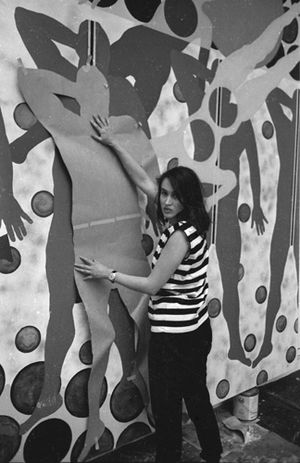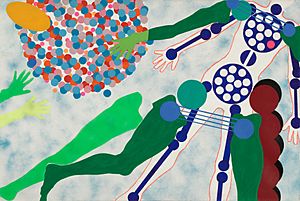Kiki Kogelnik facts for kids
Quick facts for kids
Kiki Kogelnik
|
|
|---|---|

Kiki Kogelnik, 1960s
|
|
| Born | January 22, 1935 Bleiburg, Austria
|
| Died | February 1, 1997 (aged 62) Vienna, Austria
|
| Education | Vienna Academy of Fine Arts |
| Known for | Painting Sculpture Printmaking |
Kiki Kogelnik (1935–1997) was an Austrian artist. She was known for her paintings, sculptures, and prints. Kiki was born in southern Austria. She studied art at the Vienna Academy of Fine Arts.
In 1961, she moved to New York City. Kogelnik is seen as Austria's most important artist linked to pop art. However, she often said she didn't fully belong to the pop art movement.
Contents
Early Life and Art in the 1960s
Kiki Kogelnik started her art career in Vienna in 1961. At first, she showed abstract artworks. She was influenced by artists like Serge Poliakoff. Later, she found her own unique style. This happened when she was surrounded by the pop art movement in New York.
In 1962, Kogelnik moved to New York. There, she joined a group of famous artists. This group included Roy Lichtenstein, Andy Warhol, and Robert Rauschenberg. Pop art was a way of life for them. Kiki herself became well-known for her unique hats and outfits. She was a captivating presence wherever she went.
Her art from this time used bright pop art colors and materials. She made many colorful paintings with a space theme. Unlike some pop artists, she didn't focus on everyday objects or shopping. Instead, she often used plastics and artificial things in her art.
In the early 1960s, Kogelnik started making life-size paper cutouts. These were based on her friends. By 1965, these cutouts became vinyl hangings. She showed them on clothing racks, like those she saw in New York's garment district.
In 1966, Kiki was in London. Her New York studio was destroyed in a huge fire. Luckily, she had just moved out before the fire. That same year, Kogelnik married Dr. George Schwarz, a doctor. Their son, Mono, was born in 1967. Kiki then returned to New York. In 1969, she created a Moonhappening in Vienna. This was during the Apollo 11 lunar landing. She made a series of moon-themed silkscreens while watching the live broadcast.
Art in the 1970s and Beyond
In the 1970s, Kogelnik's art changed focus. She started making what are called her Women works. These pieces looked at how women were shown in advertising. She explored feminist ideas in a unique way. She used humor and a cool pop art style. This was different from other artists at the time.
In 1974, she also began working with ceramics. She used sculptures to expand her painting ideas. In the 1980s, her art began to feature broken-up people, signs, and symbols. In her Expansions series, she combined ceramic pieces with her paintings. She also made a short film called CBGB in 1978.
In her later works, the human body was shown in more broken and changed ways. By the 1990s, much of her art showed very abstract faces. During this time, Kogelnik made glass sculptures, drawings, and prints. She used these to comment on decorative and commercial themes in art.
Legacy and Recognition
Kiki Kogelnik passed away from cancer on February 1, 1997, in Vienna. She is buried in Bleiburg, Austria. The Belvedere Museum in Vienna held a big show of her art that same year.
In 1998, Kogelnik received Austria’s highest art award. It was the Austrian Cross of Honour for Science and Art. She had also won the City of Vienna Prize for Visual Arts in 1995.
After her death, the Kiki Kogelnik Foundation was created. This group works to protect and share Kiki Kogelnik's art. They keep a detailed record of her works for art research.
In 2003, the Austrian Post office released a stamp. It featured Kogelnik’s 1973 painting, Prenez Le Temps d’Aimer. Kogelnik also designed two fountains. One is in Bleiburg, Austria, and the other is in Klagenfurt, Austria. A street in Klagenfurt is named after her.
In 2015, Kogelnik's art was part of "The World Goes Pop" exhibit. This show was held at the Tate Modern museum. It showed that Pop Art was not just an American movement. It was a global art style. Around the world, Pop Art was often used to protest ideas. It was not just about celebrating consumerism. The exhibit ran from September 17, 2015, to January 24, 2016.
See also
 In Spanish: Kiki Kogelnik para niños
In Spanish: Kiki Kogelnik para niños
- List of Austrian artists and architects


